Most of us accept the wisdom that you are what you eat. But it’s also true to say that you are where you live.
The spaces where we live, work and socialise shape our choices about our consumption and behavioural habits. These are automatic and unthinking, triggered by cues in the environment around us.
Living in a vibrant town with access to health advice, a choice of shops, accessible places to exercise and welcoming spaces to congregate makes it easier to opt for healthy lifestyle choices.
On the other hand, if you live in a place surrounded by clusters of takeaway outlets, bookmakers and pubs, those healthy choices require a more conscious effort.
The architect and former president of the Royal Institute of Architects in Ireland, Paul Keogh, cites the term "obesogenic economics", or the idea that environments help or contribute to obesity.
If you could measure the health of the main streets at the heart of our villages, towns and cities, what would that tell you about the physical and psychological health of the people who live there? And what impact might those findings have on future planning policy?
That’s the idea behind The Irish Times Healthy Streets project. We took a representative sample of 10 Irish towns and urban areas and, using a “Richter scale” – developed by the British Royal Society for Public Health (RSPH) and adapted by us for an Irish environment – calculated their overall score.
Positive or negative points are awarded to every outlet on a street: places like pharmacies and health clubs get a positive score; bookmakers and greasy spoons get a negative score. Other factors such as clusters of businesses, accessibility, public transport, access to leisure amenities and spaces to congregate with others are taken into account.
The original model developed by the RSPH “wanted to look at the physical environment, and all of the subtle, and not so subtle ways, it affects our health”, says Toby Green, policy and research manager.
“Focusing on the retail environment is one way to look at how our surroundings can affect our ability to make healthy choices, and not just focus on the willpower of the individual.”
The RSPH looked at “four different dimensions to people’s health that can be affected by high street outlets”.
“One of these was how much they promote healthier choices on the high street. Another was social interaction. The third one was access to services and advice – so things like pharmacies and health clubs scored highly on that. The fourth being mental wellbeing.”
Vacant units are regarded as having a detrimental impact on the life of a town, discouraging people from getting out and about, and having the face-to-face encounters that are crucial for psychological health and wellbeing.
As online shopping, the profusion of out-of-town retail units, our growing car culture and the high cost of doing business all continue to take their toll on the health of the Irish main street, Ireland’s urban environments clearly need to be reimagined.
From the 1960s onward, “in a sense, we voted with our feet because we moved out of towns to live in rural areas or suburban estates”, says Keogh. And then the shopping moved out of the towns too, towards places where all our retail needs were consolidated in one place. In supermarkets now, “you can buy everything from an avocado to a pair of jeans”.
But what price are we paying for that convenience? People are spending more time in their cars, and having fewer social engagements with one another. "People who are lonely have a higher degree of dementia," says Dr Jerry Cowley, GP and politician. "The more we're in touch with our local community, the more chance we have of being stimulated."
Those living in commuter towns face particular health challenges, Cowley adds. “Dublin is like a vacuum, sucking people into the centre, and there are repercussions for people left behind for their health. Nobody has thought it through.”
So many family and social events, even holy communions, take place in the pub, which I don't think is great. But I know a lot of older people who, if they didn't have a pub, would go no place else
Climate concerns mean that, one way or another, we’ll have to look seriously at moving away from the “suburban sprawl” to “compact urban forms, where people are encouraged to walk, to cycle and to live more healthy lifestyles,” says Keogh.
Some interesting insights into what that re-imagining might look like emerge in the data gathered from our Richter scale. For example, we see how towns that take advantage of their physical and geographic amenities to develop a reputation for a particular sport or activity – like the golfers' and surfers' mecca of Lahinch, Co Clare – gain more than just economic advantages.
The aim of this Irish Times project is not to create a league table of “best to worst”, but to act as a starting point for a conversation about how our urban and rural environments could be designed more imaginatively to accommodate the health and wellbeing of the people who live there.
Of course, the data can’t possibly capture all the nuances of the life of an Irish main street. One of the issues debated by our expert panel, for instance, was whether pubs should be considered a positive or a negative. Ultimately, because of the negative impact of alcohol in Irish society, the decision was taken to score them negatively.
However, as professor of sociology at Maynooth University, Mary Corcoran points out, it is also true that many "suburban pubs are not just drinking establishments". They can also be places where people get a hot meal and socialise.
There was probably too many pubs in the past, says Dr Jerry Cowley. “Unfortunately, due to lack of community centres and so on, so many family and social events, even holy communions, take place in the pub, which I don’t think is great.” On the other hand, he says, “I know a lot of older people who, if they didn’t have a pub, would go no place else.”
Corcoran adds that while not every small Irish town has a health or leisure centre, most have something better: a GAA club. “Because it’s not on the high street doesn’t mean that people in that area don’t have access to their local club. It would be a cross-gender, cross-generational facility, with no point of entry cost.”
Ireland needs to be “much more creative and innovative about how we manage our public realm”, says Corcoran. She suggests that “there is a lot of potential for nature in our townscapes, including street planting or public artworks”. Those are, she says, signifiers of a space that can help foster a sense of pride.
Corcoran believes we need to make our streetscapes “less static” and more accommodating of things like festivals, “pop-up shops, organic markets, car boot sales”,
Keogh believes that to save the high street, we’ll need to find ways to encourage people to start living there again. “The sprawling development of the 1960s is not sustainable any more. The impact of fossil fuels on biodiversity cannot continue. So how else can we live? The obvious solution is to encourage people to move back to compact urban areas. But... you go into many Irish town centres, and it’s broken footpaths, broken pavements, cars everywhere, narrow footpaths.”
The first thing that’s needed, Keogh says, is for town centres to become more attractive.
Stoneybatter, Dublin 7
Drogheda, Co Louth
Lahinch, Co Clare
Ballinasloe, Co Galway
Thurles, Co Tipperary
Clondalkin, Dublin 22
Bangor, Co Down
Ranelagh, Dublin 6
Waterford city
Greystones, Co Wicklow
GET INVOLVED: Assess your own main street and submit your findings here
STONEYBATTER, DUBLIN 7
“There’s a new generation living here now, and they all like coffee”
SCORE: 74
Total healthy outlets score 88
Total unhealthy outlets score -49
Diversity 0
Housing 6
Accessibility 2
Bike parking 3
Pedestrianisation 0
Seating/amenity area 0
Public transport 2
Traffic -1
Total 51
Total multiplied by 100, then divided by number of outlets assessed (121) to give the final score of 74
The streets we assessed
Stoneybatter and Manor Street.
Assessor's verdict
Stoneybatter has an independent greengrocers, fish shop and butchers, several pharmacies and doctors' surgeries, as well as a convenience store. It feels like somewhere you could do a family shop without the need to get in your car. The score was negatively impacted by a lack of public seating, some vacant units, and a high number of takeaways and pubs. – Jennifer O'Connell
Expert's verdict
Stoneybatter is an urban village. It's a village that just happens to be in quite a dense urban setting. And the gentrification is making the village more sustainable. It's interesting how the opportunity to interact with other people can happen in lots of different settings in a town, including in barbershops, hairdressers and pubs and bars." – Mary Corcoran
"IF A SHOP CLOSES DOWN HERE, they're in like a light, because Stoneybatter is thriving," says Des Barrett, a postman in the area for the past 15 years. "The biggest change is all the new little shops that are opening up. There isn't a spare spot in the place."
Barrett, like many other locals, mentions the summer Pride of Place festival held in the area for the first time two years ago that “brought everybody out on the street”. There’s a great community here, he says. “There are elderly people who have been here a very long time and they look out for each other. Six years ago, it was still very elderly and now there are lots of new young people coming in.”
Farther down the road, pharmacist Dominic Cooney in Manor Pharmacy says the area has been transformed in the 12 years since he began working here. Back then, “there was a lot of boarded-up premises and just a couple of greasy spoons. Now there are some really nice eateries.
“There’s still traditional old working class Dublin people, but now there’s young upwardly mobile hipsters as well.”
Where do people in the area congregate as a community? “There are quite a few social organisations for the old folks. For younger people, there are some gyms and sports facilities. There’s a thriving cafe culture. People don’t necessarily drink now for socialisation [but] sometimes the pub is just a nice place to hang out.”
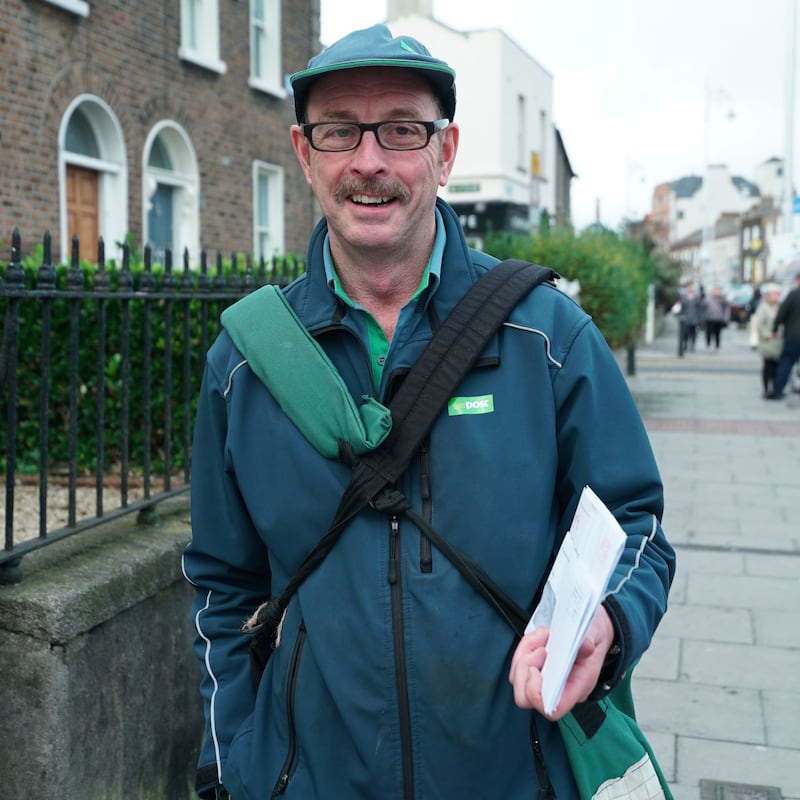
Accessibility is one of the things our score takes into account, because a healthy main street should be accessible to everyone. Here it is an issue, says the pharmacist. “Because the houses were built at the turn of the century, many of them are not very suitable for people in wheelchairs. We have a fair few visually impaired customers and they manage, but you are dealing with an urban environment, and it is tricky.”
Stoneybatter’s young “hipster” population is very health conscious, says John Ward, who is behind the till at the swish new greengrocers on the street. It was opened by his two sons, who started out with a fruit and veg box delivery service, and spotted the opportunity for a bricks and mortar presence when an empty unit in Stoneybatter came up.
“You see a lot of women coming in here with the yoga mats over the shoulders, getting their fruit and veg for their smoothies in the morning.”
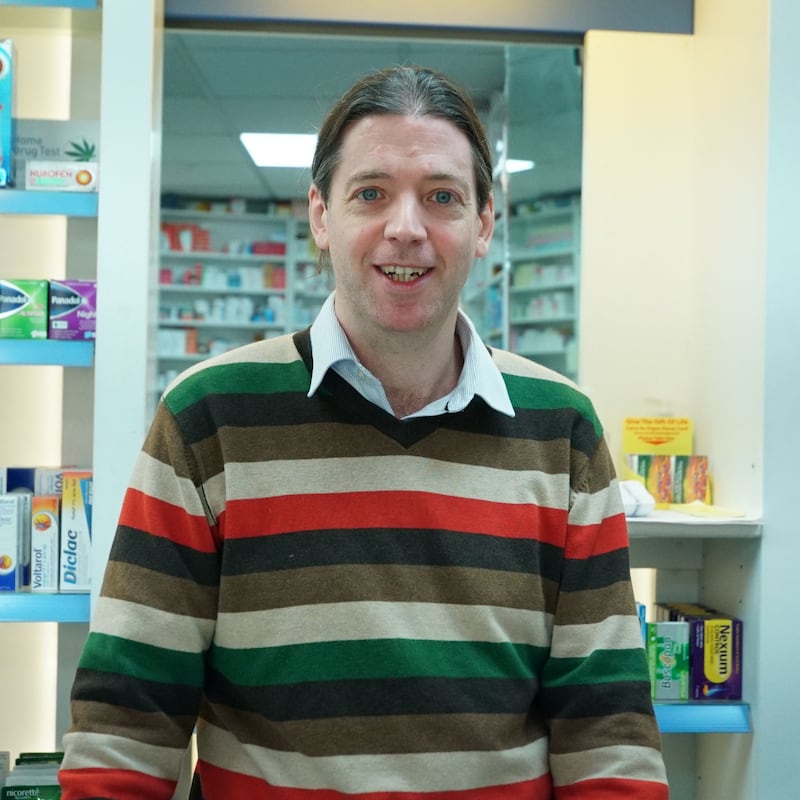
The phenomenon of Breakfast Roll Man is no more, Ward says. Now it’s all Avocado Man. Even the builders are buying avocados. People in Stoneybatter “seem to eat an awful lot of avocados. They go for the berries too, for their smoothies.”
Up at Muldoon’s fish shop, owner Hugo Muldoon is less enamoured by the gentrification. He doesn’t think the community spirit is what it was. “There’s a whole new regime,” he says. “All the old families have moved on.”
What’s the biggest difference he’s noticed? “Coffee shops. Every second or third shop is a coffee shop. There’s a new generation living here now and they all like coffee.”
But they’re not buying fish, he laments. “It’s very hard to get young people to cook. They’re going up and down there in the morning with a sausage roll, and they’re going up and down in the evening with a curry. They’re eating all the wrong things.” Years ago, there would have been queues out the door on Wednesdays and Fridays.
Lucky’s Barber Shop, which opened 11 years ago, illustrates the point made by Mary Corcoran that community gatherings can happen in informal spaces. On the day we visit, there are customers from Congo, Burundi, Nigeria, Angola, Rwanda and Dublin, and not all of them seem to be interested in a haircut.
“Not everybody comes in here for a haircut. Some come and sit down to watch the match,” says Lucky. “Some people ask me why do you do that? Everybody’s free to come in. That’s the way it is. Maybe the next day, he will come back and he will bring his cousin [or] his friends and they will have a haircut.”
[ Back to top of assessments ]
LAHINCH, CO CLARE
“There’s a real injection of young surfing families”
SCORE: 202
Total healthy outlets score 122
Total unhealthy outlets score -19
Diversity 6
Housing 6
Accessibility 1
Bike parking 0
Pedestrianisation 0
Seating/amenity area 6
Public transport 2
Traffic -1
Total 123
Total multiplied by 100, then divided by number of outlets assessed (61) to give the final score of 202
The streets we assessed
Main Street and surrounds.
Assessor's verdict
"Lahinch makes excellent use of its natural amenities and proximity to the sea, with multiple surfing centres, a surf shop and a leisure centre. The nearby golf links course and an active walking group, though not included for scoring purposes, add to the impression of a town where physical activity is a priority. That focus is reflected in the range of healthy food offerings in the cafes." – Jennifer O'Connell
Expert's view
"The sea and promenade feature hugely in the lives of people in Lahinch. There is research that shows that people who live near the sea live longer, and maybe what we're seeing here is because it encourages them to get active." – Mary Corcoran
ROSEMARY BUCKLEY IS behind the counter in Lahinch Surf Shop, the oldest surf shop in one of the oldest surfing communities in Ireland.
The shop, which is tucked away on a lane off the Main Street, was set up by her late husband, Tom, 30 years ago. By then, Lahinch was already well established as a surf destination. Today, “there is a very healthy population here”, she says. “All the young guys and girls around just get out there and get on with it. Even on the coldest day, there are people out there surfing.”
The town has benefited from an influx of remote workers choosing to live here, drawn to the promise of endless surf, a good lifestyle, a great community, and an excellent local national school, which teaches golf and search-and-rescue to the children.
One of those who moved to Lahinch in search of a better quality of life is Waterford-born John McCarthy. He opened the Lahinch Surf Centre in 2002, the first in the town. Now it’s one of five. “A lot of people moved here over the last 10 or 12 years. One or both of them surfs, and they’ve decided to base their career and lives here.”
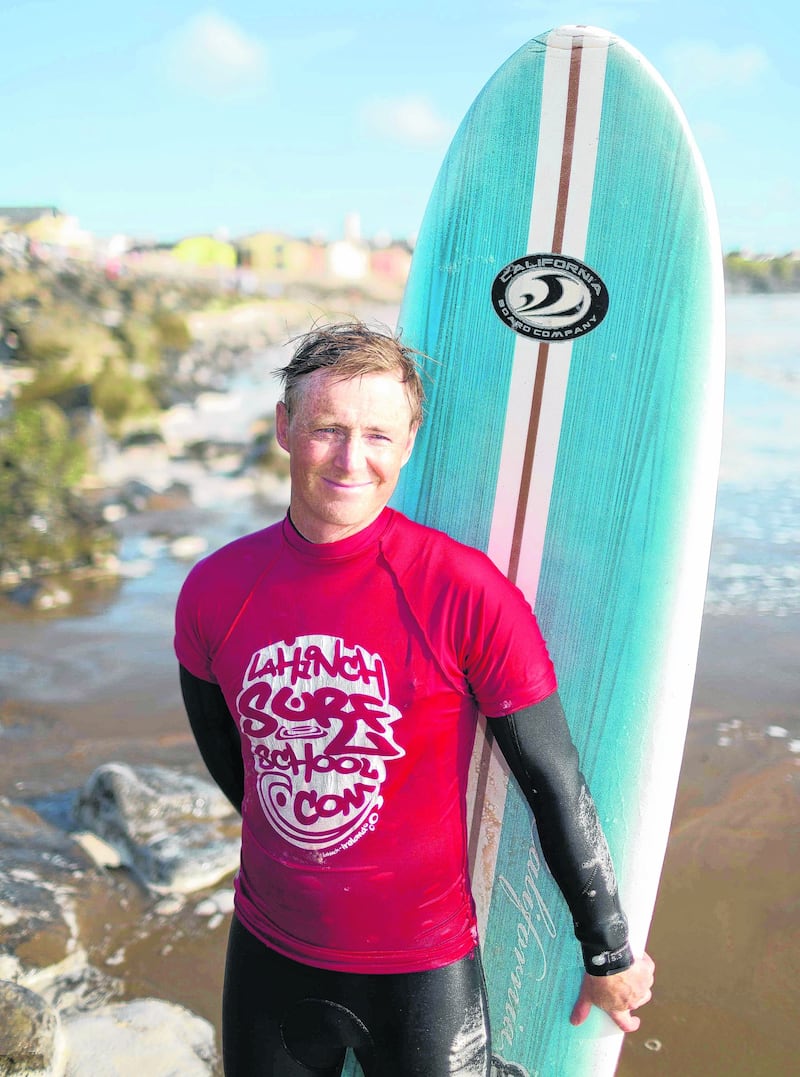
Surfing is growing in popularity with both genders and all ages, he says. “Fifty five per cent of our customers are women. It’s not at all uncommon now to see a group of women all in their 40s, all out surfing together now.”
The knock-on effect of Lahinch’s popularity with visitors, long-standing residents and relative newcomers means there is a good variety of shops along the Main Street open all winter, when The Irish Times assessment was carried out.
There are several busy cafes and restaurants, many of them with a range of healthy choices on the menu. As I walk up and down the Main Street counting units, a group dressed in office wear strides past. “I try to get out for half an hour at lunchtime every day,” one of them is saying. Your average, deserted seaside town in mid-winter this is not.
Buckley’s daughter, Eileesh, used to work for Intel in Shannon. She has also come back to Lahinch for the good life – but because the life is so good, she can’t afford to buy a house in the town. What are the advantages of life here? “Clean air, close to nature. You can go surfing, you can go swimming. You’re close to the Burren. And Ennis is only 20 minutes away, so if you want to go to the theatre, you can go there.”
Rose Kenny is overseeing a renovation of the gallery in Kenny’s on Main Street, which is due to re-open shortly. “Lahinch is a really up-and-coming place, especially with the Irish Open coming. It’s giving the whole town a real boost. We’ve been developing a Tidy Towns committee, which was never heard of before in Lahinch.”
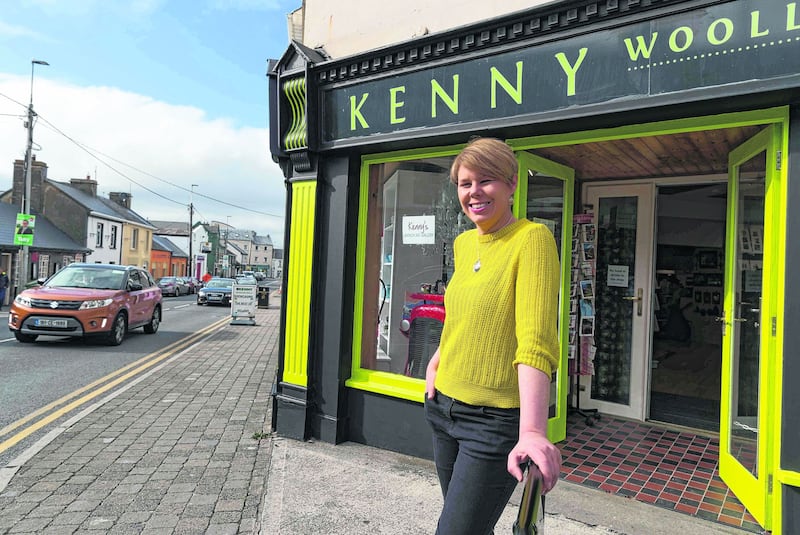
The town has a strong sense of community, and everything you could need to live here, says Pauline in the Lahinch Book Shop, listing them off. “There’s a chemist, there is a very good supermarket. You have your takeaways. There’s a pub if you want to go for a drink. There is a post office and a supermarket. There are lovely clothes shops, two beauty parlours, a hairdressers. There’s a Pilates and yoga studio, and another Pilates place. And there’s the surf shop. There is a walking club too, and a gym. So you have everything you need.”
One of the more divisive aspects of Lahinch’s popularity is its reputation as a destination for hen and stag parties. “We love the stag parties at Lahinch Surf School. We get to encourage them along, and wash them off, and do something positive. Our myopic view on it is that it’s all wonderful. And it’s part of what sustains the surf schools in the off season,” says McCarthy.
Up on the Main Street, Donogh O’Loghlin in the high-end clothing shop of the same name, is less enthusiastic. He brings me outside to show where his front window was smashed during separate recent stags. “That window was broken in March. That window was broken in August. And that crack in the window there is going to cost me €4,500 to replace.”
It is a source of frustration to O’Loghlin and others in the town that the buses coming to and from the Cliffs of Moher typically just pass through without stopping. But the development of new toilet facilities and better parking will, it’s hoped, rectify that. Overall, he says, Lahinch’s Main Street is in good shape. “They’re very lucky here in the location. They have the beach, a wonderful golf course, good accommodation, nice shops, good restaurants. There’s an awful lot in place here” for the town to take off.
[ Back to top of assessments ]
DROGHEDA, CO LOUTH
“In the next 10 years, Drogheda will mushroom”
SCORE: 36
Total healthy outlets score 101
Total unhealthy outlets score -77
Diversity 6
Housing 0
Accessibility 2
Bike parking 3
Pedestrianisation 0
Seating/amenity area 6
Public transport 2
Traffic 0
Total 43
Total multiplied by 100, then divided by number of outlets assessed (121) to give the final score of 36
The streets we assessed
Shop Street and West Street.
Assessor's verdict
"Drogheda's overall score was negatively impacted by the large cluster of vacant units at the far end of West Street. However, there are plans to regenerate it significantly over the next three years. Out-of-town retail parks have had a negative impact on footfall in the town centre, though a handful of traditional independent businesses are holding their own." – Jennifer O'Connell
Expert's view
"Historically people shopped on the main street, and people lived over the shop. From the 1960s, that was reversed, and most towns now have a 'retail park' where you can buy everything. It has become a Catch-22 situation. Things get built outside the town because parking is available, then everyone has to drive to get there." – Paul Keogh
"WHAT HAPPENED TO West Street, Lily?" one woman, Anne Thornton, asks her friend, Lily Whelan, when I stop them for a chat on Drogheda's main shopping strip. She points down the street in the direction of what another local dubs, "the post-Glasnost era of vacant shops and abandoned units". "It's dead up there."
This used to be known as the Golden Mile, Thornton says.
“We come down West Street now and we seldom meet someone we know. We need a lot of good new shops here. They expect us to go up to the retail parks, but what about the like of us who have no cars?” says Whelan.
“Drogheda is the forgotten town,” says Thornton.
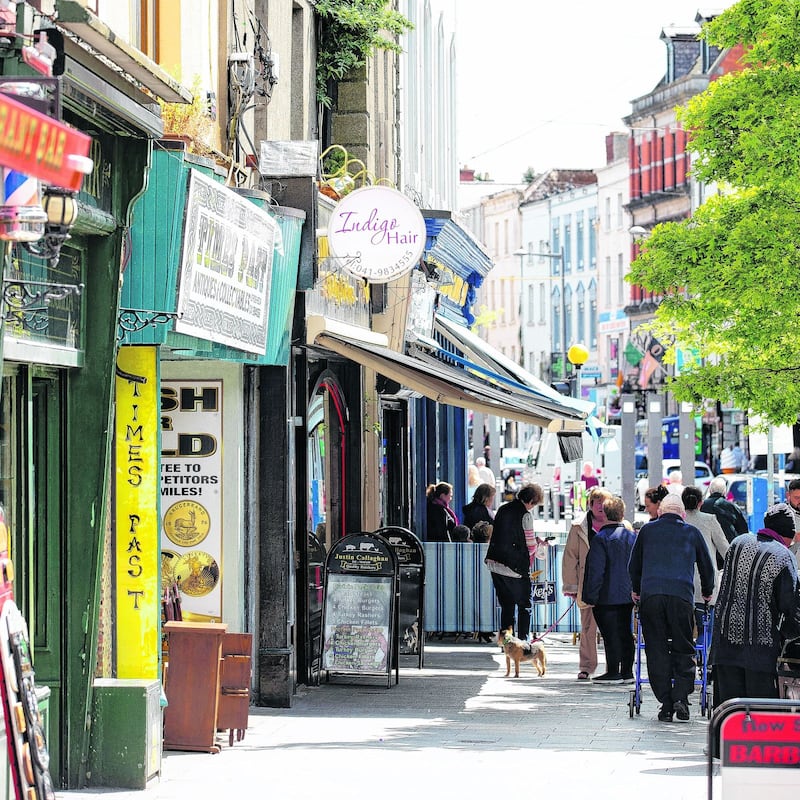
But despite the highly visible problem of the empty units, everyone I speak to agrees with the view of Nikki McComeskey, who is meeting friends for lunch in town, that “there are some really good retailers in town and they’ve weathered some tough storms. Drogheda is a beautiful town and has so much potential for tourism,” she says.
Paddy Dwyer in Paddy Dwyer Shoes, one of Drogheda’s longest-standing family businesses, is optimistic about the future. “It’s no secret that retail has got more difficult. But Drogheda is more than holding its own retail-wise, and the whole tourist end of it is helping greatly. This town is going to explode. It’s so close to Dublin, and has all the advantages that come along with that. We’re fighting for city status.”
Retail now is all about specialising and offering the best possible customer service, he adds. “Let’s say I had 50 customers today, I’d guarantee you 45 are repeats. We can all hit the buy button online, but there’s nothing nicer than being greeted by somebody offering a good service.”
Of the cluster of empty units, he says: “On Shop Street, there are 28 units, with 27 of them trading. There is a plan for that end of town, and obviously we’d like to see a magic wand.”
Miriam Maher in the Town Centre pharmacy says out-of-town retail parks have made things tough for retailers on the main street. She shares Dwyer’s view that “a good service and a variety of product you won’t get anywhere else” are key. Even so, “people aren’t spending like they were pre-recession”.
There’s a Bus Éireann service bringing people into town, “which is vital for the high street here” and for the elderly.
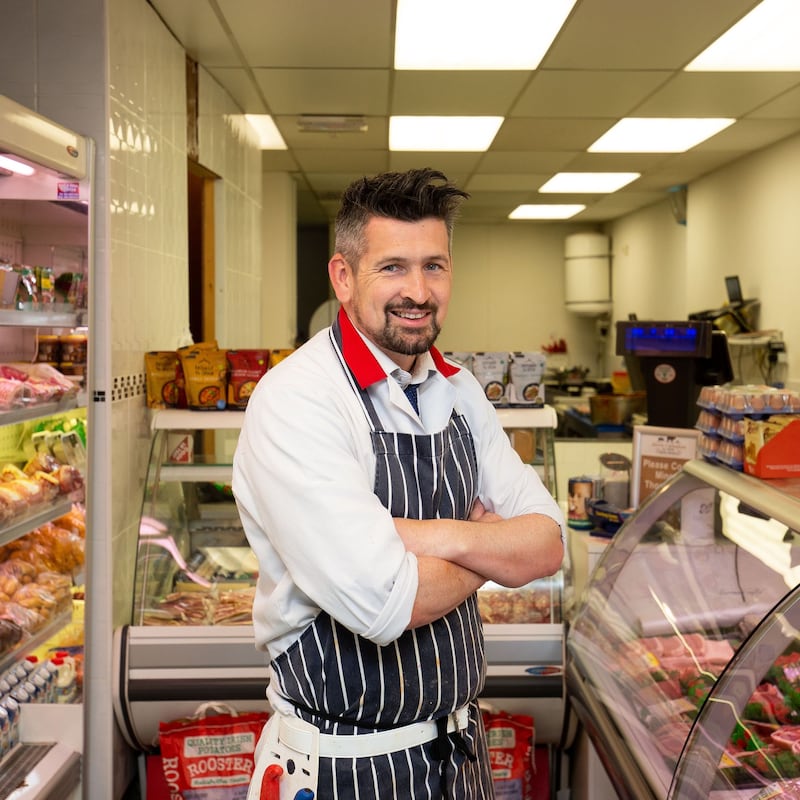
“You have good days and bad days,” says Justin Callaghan of Justin Callaghan & Sons butchers, one of Drogheda’s thriving family businesses. The shop’s customers are a mix. There’s one older woman “who comes in here six days a week, then she’d go and have a cup of tea over in the West Court, then she goes and has a talk with her friends, and goes on home”, her need for social engagement taken care of.
Callaghan appeals to young shoppers with “healthy birds – turkey burgers, turkey rashers, and our own turkey sausages, chicken sausages and pork sausages”. But they’re still a tough audience. “This generation that’s coming up now, it’s all the internet.”
Like other retailers we spoke to in other towns around the country, he mentions the high cost of doing business and the challenge of competing with out-of-town retailers. “The rates here are colossal. There’s an awful lot of empty units. But nobody’s going to take a chance [on opening a new business] when they have to pay out so much money so quick.”
Despite all of the challenges, Paddy Dwyer is of the view that Drogheda’s best days are yet to come. “In the next 10 years, Drogheda will mushroom. Wait until you see it.”
[ Back to top of assessments ]
BALLINASLOE, CO GALWAY
SCORE: 28
Total healthy outlets score 73
Total unhealthy outlets score -56
Diversity 0
Housing 0
Accessibility 4
Bike parking 0
Pedestrianisation 0
Seating/amenity area 0
Public transport 4
Traffic 0
Total 25
Total multiplied by 100, then divided by number of outlets assessed (89) to give the final score of 28
The streets we assessed
Dunlo Street and Main Street.
Assessor's verdict
"The main streets contain many fine Palladian town houses, most now in inappropriate use and poor condition. Before the bypass, all Dublin-Galway traffic went through the town centre. Now, shopping has largely vacated the town centre. The centre has a significant cluster of empty units, but one or two good cafes buck the trend and seem to be a hub of community activity." – Paul Keogh
Expert's view
"The high street in rural Ireland is part of the fabric of life. It's where you found the pub, the doctor, the school, the vet, the post office. If we don't save the high street, you get the vicious circle of continuing rural depopulation." – Jerry Cowley
[ Back to top of assessments ]
CLONDALKIN, DUBLIN 22
SCORE: 48
Total healthy outlets score 35
Total unhealthy outlets score -24
Diversity 0
Housing 6
Accessibility 3
Bike parking 0
Pedestrianisation 0
Seating/amenity area 0
Public transport 2
Traffic 0
Total 22
Total multiplied by 100, then divided by number of outlets assessed (46) to give the final score of 48
The streets we assessed
Main Street and Tower Road.
Assessor's verdict
Clondalkin's score was negatively impacted by two bookmakers and three pubs within close proximity of each other. Similar to some other towns we assessed, it has a disproportionate number of hair salons, barbers and beauty salons which, though not a negative in themselves, do detract from scoring when they occur in a cluster. It also has a high number of takeaway and fast food outlets. Clondalkin's positives include residential homes on the main street and a pharmacy." – Jennifer O'Connell
Expert's view
Clondalkin village has some very nice heritage aspects" that could provide a basis for regeneration. – Mary Corcoran
[ Back to top of assessments ]
THURLES, CO TIPPERARY
SCORE: 63
Total healthy outlets score
Total unhealthy outlets score
-45
Diversity
0
Housing
0
Accessibility
4
Bike parking
0
Pedestrianisation
0
Seating/amenity area
0
Public transport
4
Traffic
0
Total
48
Total multiplied by 100, then divided by number of outlets assessed (76) to give the final score of 63
The street we assessed
Liberty Square
Assessor's verdict
There's big controversy in Thurles at the moment because An Post has announced that the post office in Liberty Square is moving to the shopping centre. The square has been dying for years, and this is one of the biggest losses for it. There is a health and leisure centre, library, public park, skateboard park and public seating a few minutes' walk over the bridge across the River Suir. Not close enough to be included in the assessment, but a great amenity. – Damian Cullen
Expert's view
A lot of smaller Irish towns are suffering because all the job growth is happening in Dublin. Is an IT company going to move to Drogheda or Ballinasloe unless they know the workforce is available? Probably not." – Paul Keogh
[ Back to top of assessments ]
BANGOR, CO DOWN
SCORE: 79
Total healthy outlets score 65
Total unhealthy outlets score -21
Diversity 6
Housing 0
Accessibility 3
Bike parking 3
Pedestrianisation 0
Seating/amenity area 6
Public transport 2
Traffic -1
Total 63
Total multiplied by 100, then divided by number of outlets assessed (80) to give the final score of 79
The street we assessed
Main Street.
Assessor's verdict
Bangor is a large seaside-market town on the Co Down coast, and a commuter town for the greater Belfast area. On a weekday morning, the street was busy with shoppers, but the presence of several large vacant units is evident. The large shopping centre at the seaside end of Main Street is now vacant. Bangor's score was boosted by the high number of churches, spiritual centre, community centres or schools, and the three GPs, optician, dentists. It has no bookmakers, and just one pub." – Fionola Meredith
Expert's view
The shopping centre closing down exemplifies the move away from retail to online shopping. But the world is changing, and how we consume is changing. It's hard to see whether that can ever be fully rehabilitated." – Mary Corcoran
[ Back to top of assessments ]
RANELAGH, DUBLIN 6
SCORE: 100
Total healthy outlets score 127
Total unhealthy outlets score -39
Diversity 6
Housing 0
Accessibility 2
Bike parking 3
Pedestrianisation 0
Seating/amenity area 6
Public transport 4
Traffic -1
Total 108
Total multiplied by 100, then divided by number of outlets assessed (108) to give the final score of 100
The street we assessed
Main Street.
Assessor's verdict
Ranelagh is well serviced for restaurants, public transport and a good variety of independent retailers. We counted 19 restaurants and food-focused cafes and a further six coffee shops/delis – which though a positive begin to detract from the diversity of the area. It is also well served for health advice, with a number of pharmacies, health services and a leisure centre. Its score was negatively impacted by a high number of pubs or wine bars and a cluster of eight vacant units." – Jennifer O'Connell
Expert's view
"Ranelagh isn't about its visual appeal. It's a state of mind. It's a D6 state of mind. It's chock-a-block with nice restaurants because people who live in Ranelagh can probably afford to eat out five nights a week." – Mary Corcoran
[ Back to top of assessments ]
WATERFORD CITY
SCORE: 100
Total healthy outlets score 109
Total unhealthy outlets score -32
Diversity 6
Housing 0
Accessibility 4
Bike parking 3
Pedestrianisation 2
Seating/amenity area 6
Public transport 2
Traffic 0
Total 100
Total multiplied by 100, then divided by number of outlets assessed (100) to give the final score of 100
The streets we assessed
Barronstrand Street, Broad Street and Michael Street.
Assessor's verdict
Barron and Michael Streets's main amenities are a library and the pedestrianisation of the shopping area. There is extensive public seating encouraging people to linger. It also has an independent bookshop, with a large cafe. But the relatively high score belies some obvious problems: a cluster of vacant units, and a disproportionately high number of mobile phone and internet shops. Because of the way Waterford town centre is laid out, the majority of restaurants and pubs are located in areas away from the main shopping area. – Jennifer O'Connell
Expert's view
After the decline in Waterford Glass manufacturing in the city, Waterford took the initiative to invest in the quality of its public realm offering to generate inward investment and urban vitality. That's what has to be done in other Irish towns. – Paul Keogh
[ Back to top of assessments ]
GREYSTONES, CO WICKLOW
SCORE: 124
Total healthy outlets score 80
Total unhealthy outlets score -23
Diversity 6
Housing 6
Accessibility 2.5
Bike parking 3
Pedestrianisation 0
Seating/amenity area 6
Public transport 4
Traffic 0
Total 84.5
Total multiplied by 100, then divided by number of outlets assessed (68) to give the final score of 124
The street we assessed
Church Road (from Bellevue Road to the Dart station).
Assessor's verdict
The town has a compact shopping district, easily accessible by public transport, making it an appealing place to spend time. It is well serviced for restaurants, and has a very attractive park at the end of Church Road. Its accessibility score was offered by a wheelchair user, who described Church Road in general, and the shops in particular, as difficult to navigate." – Jennifer O'Connell
Expert's view
Greystones' success is a byproduct of affluence. Scale is also an issue: it's compact enough that the development has been all in one area. It has retained it authenticity; it hasn't been overdone. – Mary Corcoran
[ Back to top of assessments ]
HOW WE SCORED EACH AREA
The purpose of the Irish Times Healthy Streets project is to stimulate a conversation about the interplay between public health, planning and the future of our towns.
Based on an adapted version of methodology developed by the UK Royal Society for Public Health (RSPH), for its Health on the High Street initiative, The Irish Times set out to measure the health of the main streets in 10 Irish cities, towns, villages or suburbs.
The panel of experts
We convened a panel of three professionals with relevant expertise to assist with the project.
Paul Keogh is an award-winning Dublin-born architect and former president of the Royal Institute of the Architects of Ireland. He has a deep interest in urban sustainability.
Mary Corcoran is professor of sociology at Maynooth University, and a graduate of Trinity College Dublin and Columbia University, New York. Her interests include urban transformation and suburbanisation.
Dr Jerry Cowley is a medical doctor and former TD based in Mulrany, Co Mayo. He has campaigned on issues surrounding healthcare services in rural Ireland.
The research
The locations were chosen to provide geographical diversity and different types of main streets: a west-of-Ireland tourist town; a small city; an affluent suburb; a midlands market town; a commuter town; a traditional suburban village and so on.
There are, of course, limitations to data mapping, and the scores on this page should be seen as a snapshot in time. Between January and April 2019, we visited the sample of 10 and awarded scores to every business or retail outlet on the main street according to whether it might have a positive or negative impact on the public’s health in a community.
While we have made every effort to apply the criteria objectively, an element of subjectivity comes into any such assessment. For example it is not always clear where a street starts and ends; it may also change name yet be the same street. In the case of small villages, where the town is comprised of a single street, we included surrounding amenities immediately adjacent. Researchers were asked to use their best judgment in such circumstances.
We looked at four key measures. Does it encourage healthy lifestyle choices? Does it promote social interaction? Does it allow greater access to health services and/or health advice? Does it promote mental wellbeing?
The scoring
Positive and negative scores were given to each premises on the street, using an adapted version of the RSPH's scale.
A GP or dentist’s surgery attracted a positive health score of 7. A pharmacy received 5. Each off-licence or bookies was scored negatively (-3), as were fast-food outlets (-1 each). If the shop or business was considered to be neutral or not relevant to health, the score was 0.
There were some additional points for other attributes. If a street was 10 per cent or more domestic accommodation, it got 6 extra points. A public seating or amenity area also attracted 6. Access to public transport added 2.
Other considerations
Accessibility Where possible, the accessibility assessment of 0-5 was carried out by someone with a disability. In other circumstances, a health profession was asked to assist.
Pubs They can play an important part in community life, but can also negatively affect mental and physical health. Pubs were scored positively in the UK survey, but we adjusted this to a minus score for Ireland.
Vape shops The RSPH rates vape shops positively, but our panel had reservations about their impact on public health. Ultimately, while agreeing with the RSPH that vaping is healthier than traditional smoking, we adjusted the positive score downward from +3 to +1.
Retail diversity Our expert panel believes every healthy community should have access to basic amenities: a food retail outlet; somewhere to socialise like a pub, café or restaurant; a pharmacy; a bookshop; independent retailers; bank; library; art gallery or community recreation space. We added 6 points if a high street had five or more from this list. Similarly, a clustering penalty was applied if 5 per cent or more of the premises in an area were of the same type.










